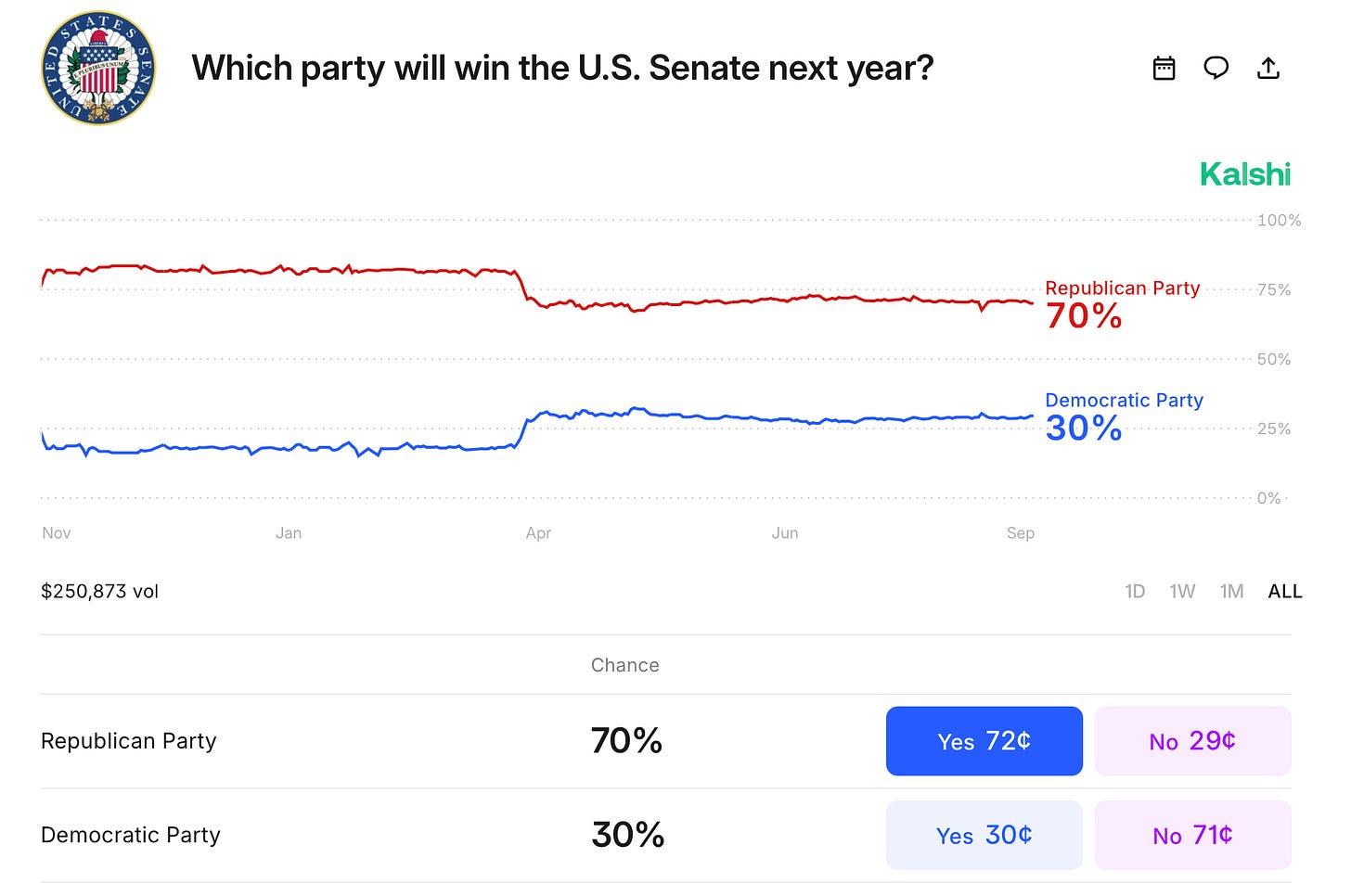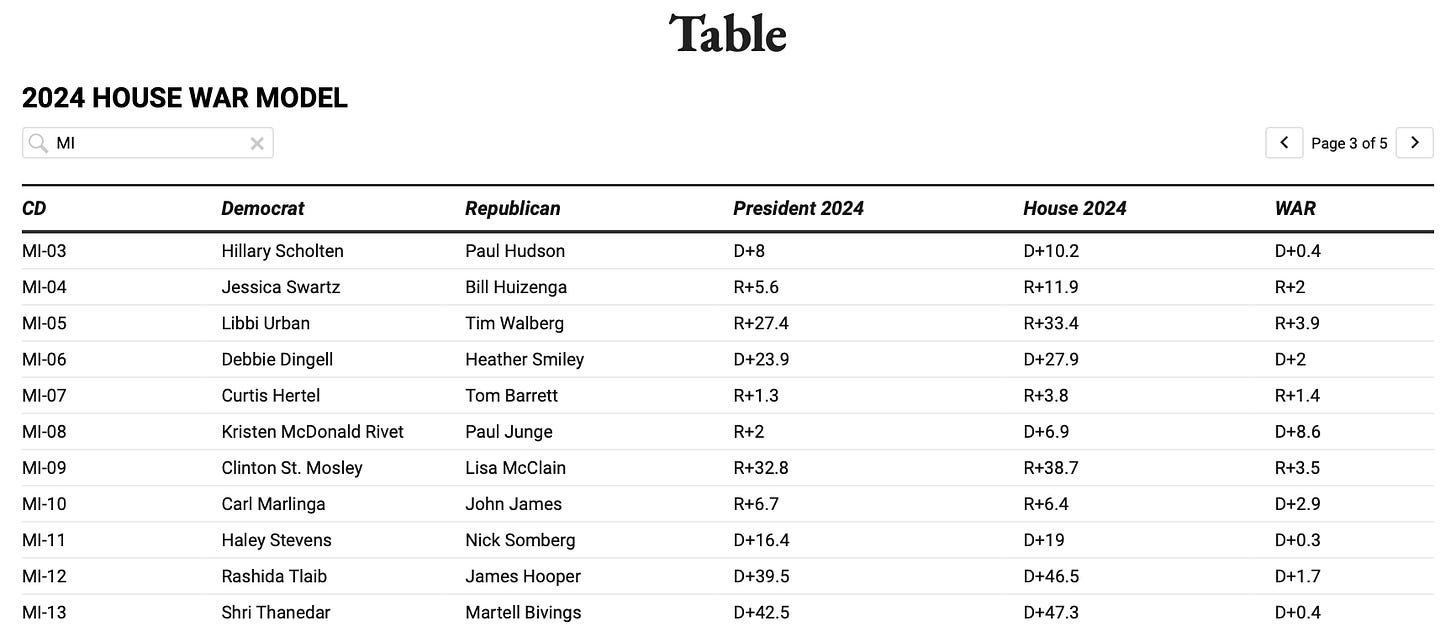The state of the 2026 Senate map
Not terrible, not great
Donald Trump has lost a lot of cases in court, which is typically what happens when you do a lot of illegal shit.
Still, nobody should be such a high-trust institutionalist as to assume “The courts will save us” — not only because of the limited powers of the judiciary, but because, ultimately, “the courts” are human beings. Right now, in addition to Democrats, the federal judiciary includes a lot of George W. Bush appointees and generic Federalist Society types who Trump appointed during his first term and who could have served in any Republican administration.
Those people often rule with Trump because of an alignment on values and policy. But they were not selected for personal loyalty to Trump or to the MAGA movement.
In his second administration, though, Trump has not only completely cowed congressional Republicans, he’s achieved mastery over the appointment process. Everyone in his current administration understands themselves to be facilitating the Trump Movement, not simply riding in its wake to advance conservative policy ideas. As a result, with every passing month, the judiciary gets a bit more MAGAfied, and the prospects for the rule of law being upheld get weaker.
Democrats can prevent this, if they can leverage Donald Trump’s unpopularity and their advantage in lower turnout elections into a Senate majority. That seems doable in principle. But it means Democrats need to win in states like North Carolina, where Trump won narrowly three times in a row, and in states like Iowa and Ohio and Alaska and Texas that weren’t particularly close. My main disagreement with virtually every piece of left-of-center political commentary in 2025 is that the left simply does not focus on this question. Not, I think, because the writers disagree with me about the objective importance of the Senate. But simply because these are smart people who know perfectly well that the messages and strategies they find most emotionally satisfying won’t generate a Senate majority, so they prefer not to think about how to get there.
But this is genuinely the most important question right now, and so today and tomorrow, we’re going to check in on how it’s going.
I would say the answer is, broadly speaking, not that great. Gamblers are fairly confident that Republicans will hold the upper house, which means they’ll continue filling the courts with MAGA toadies who shred the Constitution.
Tomorrow, behind the paywall, we’ll take a closer look at the national party’s strategy for winning the Senate. Because frankly, I think a lot of progressives’ discontent with party leaders is downstream of the fact that they haven’t presented a compelling vision of a path to a majority. To be sure, doing that would require saying some stuff that progressives don’t like. But nobody is actually happy with the status quo — and they shouldn’t be.
Today, though, we’re taking a more granular approach. The Senate map is, of course, composed of individual states, and the particulars vary significantly among them, so here’s a look at how things stand, state by state.
Maine: rising variance
People I know, like, respect, and normally agree with about electoral matters are on the verge of tears over the Maine Senate race.
Susan Collins is clearly, on paper, the most vulnerable Republican in the caucus, and Maine has no shortage of Democratic statewide elected officials, plus Jared Golden, any of whom seem like they would be strong candidates. And yet, all have bowed out of challenging Collins, and the candidate with the most buzz is an oyster farmer named Graham Platner who loves populist economic rhetoric. I had his oysters several times earlier this summer before he announced his candidacy (they’re good), and I met him shortly after the announcement. He’s funny and charismatic, a really strong “outsider” recruit.
Where I differ from my pessimistic friends is that I think all the professional politicians who bowed out of this race are correct and the odds of beating Collins are actually just objectively quite low (Eli McKown-Dawson has a good overview of both sides of this argument).
She survived the 2008 and 2020 cycles, and I don’t see any reason to think the national political climate will carry her out in 2026 after she voted to convict Trump and against the One Big Beautiful Bill. Platner will also probably lose, possibly catastrophically, but he increases the variance, which is good. I think that to pull off the populist shtick, he needs to get in touch with a little bit more of the pro-gun/anti-woke spirit of Bernie 2016, which he may not be willing to do.
A second outsider Democratic candidate, brewery owner Dan Kleban, has also entered the race and also seems like a plausible longshot. If American parties had proper factional organizations, though, we would give this one to the left-populists in exchange for them standing down elsewhere.
Michigan: rising variance, in a bad way
The state I’m sweating is Michigan. I’d expect a generic Democrat to beat a generic Republican in a Trump midterm climate in this purple state. But the left is making a strong play to win this nomination with Abdul El-Sayed, who’s a very nice, very smart person, but I just see no reason to think that voters in this slightly red state are particularly excited about an unusually left-wing Democrat.
To make matters worse, the party establishment decided to line up behind Haley Stevens as the electable alternative. Stevens is an unremarkable mainstream House Democrat on ideology, but, she has literally the worst wins-above-replacement (WAR) rating among the six House Democrats from Michigan. You guys know that I think moderation and policy positioning are incredibly important, but they’re not all that matters in politics and Stevens is literally a worse performer than Rashida Tlaib.
I’m not totally sure I buy that Tlaib would be a stronger Senate nominee, but it’s irresponsible not to have tried to recruit Kristen McDonald Rivet. The third horse in this race is Mallory McMorrow, who got incredible hype after going viral in 2022. I would have told you two years ago that she was overrated, but even correctly rated she seems like a distinctly better option than El-Sayed or Stevens — this is a good video!
I feel like it just should not be that hard to win here, but Democrats stand a decent chance of bobbling it. That said, the gamblers are more optimistic than me.
North Carolina: better lucky than good
Everything is going Democrats’ way in North Carolina, where they successfully recruited two-term incumbent governor Roy Cooper, who left office just last year. Beating incumbent Thom Tillis would have been hard, especially if Tillis made a few gestures of moderation. But Trump decided to behave like a maniac and scourge Tillis over minor acts of heterodoxy, causing him to retire rather than risk potentially losing a primary.
We’re still talking about a state that Trump won three times. But Cooper has won six statewide races (he was attorney general before he was governor) and successfully passed the baton to his chosen successor as governor, so there’s every reason to believe that he understands the NC electorate and will run a smart campaign. I think you could make the case that the political savvy of the Senate Majority PAC (S.M.P.) and the Democratic Senatorial Campaign Committee (D.S.C.C.) has become overrated, because they keep benefiting from terrible Trump decision-making about candidate selection, which is not actually under their control. But, as they say, better lucky than good!
Iowa: the time to be good
Iowa is the kind of state where Democrats need to compete to have a real shot at the Senate over the long term. It was a swing state in the recent past; Barack Obama won it twice. But it also went 56-43 for Trump last year, so it’s going to be incredibly difficult for Democrats to win there in 2026. The incumbent, Joni Ernst, has decided not to run for re-election, which is good luck for Democrats. Unfortunately, Rep. Ashley Hinson, who’s stepping into the race on the G.O.P. side, seems like a solid candidate, and there’s no sign of Trump creating chaos there. The main beneficiary of Ernst’s retirement is actually House Democrats, who now have a shot at picking up Hinson’s seat.
My concern on the Democratic side is that we’ll end up nominating Zach Wahls, a former Senate minority leader who I’ve met several times over the years on the circuit of “rising stars” and election postmortems. Wahls is a great guy, and everyone likes him. I’m sitting here at my keyboard, very much not wanting to say anything negative, but I wish he had been born in Wisconsin or Michigan or some other state where a bright, personable young guy with good national connections and mainstream views would be an ideal candidate. There’s just nothing in his electoral track record to suggest he’s capable of putting up the kind of monster over-performance Democrats need to win Iowa. The best recruit for D.S.C.C./S.M.P. would have been Rob Sand, the state auditor, but they couldn’t convince him, so he’s running for governor instead.
But, one sliver of hope: There’s another state legislator in the race, Paralympian Josh Turek, whose electoral track record is stellar and whose numbers in his district do suggest a level of over-performance that could win statewide. His video is killer. This is the place for Senate leadership to be smart and tell donors and others in the national network something they may not want to hear, which is that Turek is clearly the party’s best shot at winning this race.
Ohio: ¯\_(ツ)_/¯
Running Sherrod Brown again in Ohio is the definition of an uninspired move, but it is in fact true that he posted a pretty good WAR score in 2024 and could win if there’s a better national environment in 2026.
I’m also glad that Brown seems to be trying to defuse the strong crypto-industry opposition he faced last time around. Democrats’ instinct to make crypto the thing to moderate on after losing in 2024 feels a little pathetic, but it’s better than moderating on nothing. The thing that I would really like Brown to ponder is that Obama, who won Ohio twice, was moderate on energy policy and loved to tout his “all-of-the-above” approach, and Brown always positioned himself as clearly to Obama’s right on climate and energy issues. I was genuinely baffled by his decision to forget all about this in 2021 and 2022 and instead let Joe Manchin take all the brickbats from the left.
Texas: a new hope!
Colin Allred is running here again. Like Brown, he had positive WAR in his last campaign, but it just wasn’t good enough to win in a state that is extremely red.
Also running is James Talarico, a state legislator who is best known to national audiences for impressing Joe Rogan. I think that being able to go on right-leaning media and be impressive is the best possible way to win in a right-leaning state, so I’m inclined to say this would be a better choice than Allred. But Allred is a pretty good choice as well, and my main fear is that with two strong candidates in the race, they end up boxing each other into excessively progressive policy positions that make it impossible to win.
It also just seems obvious that the way to win in Texas is to recruit a moderate Hispanic candidate from the Rio Grande Valley (R.G.V.). There are plenty of options to choose from, including Vicente Gonzalez in the House and former Rep. Filemon Vela. And precisely because this is an area that’s swung right at the top of the ballot in the past couple of cycles, there are plenty of down-ballot R.G.V. Hispanic Democrats. It’s just crazy to me that this is not on the table for 2026. But Allred is a decent candidate, and Talarico is an exciting new option.
Waiting for Alaska: still waiting for a message
Trump actually got a lower share of the vote in Alaska than he did in Ohio, Texas, or Iowa. The dream recruit here is former Rep. Mary Peltola.
But precisely because Alaska is one of the better pickup opportunities and Peltola is one of the best possible recruits, it’s worth stepping back to look at what I think is Democrats’ fundamental issue with the Senate, which is more strategic than tactical. If your incumbents in Pennsylvania and Colorado are already against a fracking ban, and your hopes for winning a majority run through Alaska and Texas and Ohio, then why can’t we bring back the “all-of-the-above” energy policy as the Democratic Party platform? Why create a toxic national brand and then try really hard to recruit candidates who can distance themselves from it?
Come back tomorrow, when we’ll try to answer those questions.





Texas Democrat working in the oil and gas industry chiming in to say that I think the absolute best option would be to recruit a retired oil and gas exec to run as an independent, with the platform of “Trump is bad for our state’s oil and gas industry.” Which is true! Tariffs are terrible, trade wars are terrible for commodity businesses, and Trump is very clear that he wants low oil prices! Throw in some stuff about being a good Christian man that contrasts with Trump. The modal Texan (AND the modal oil and gas executive) doesn’t like Democrats but also doesn’t like Trump at all. “We need an independent voice that will stop these harmful tariffs,” something along those lines.
My 2¢ is that we should not have an 80 year old running for re-election in Massachusetts